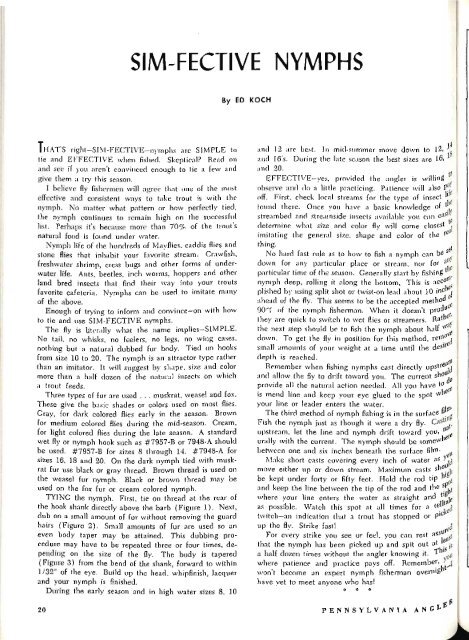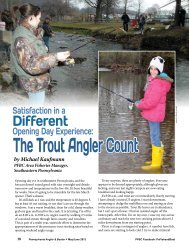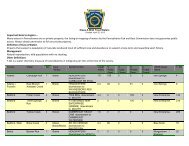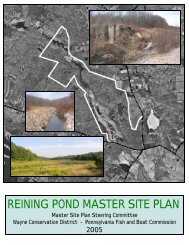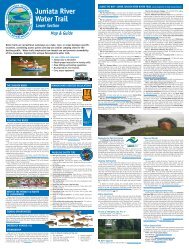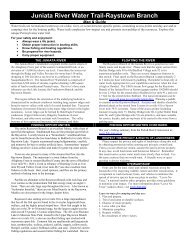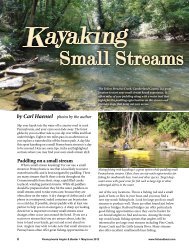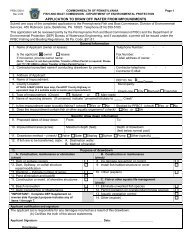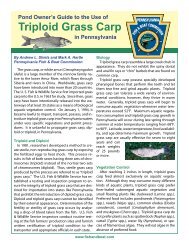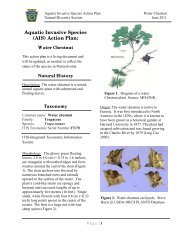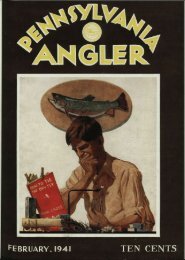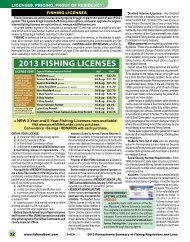m&M: - Pennsylvania Fish and Boat Commission
m&M: - Pennsylvania Fish and Boat Commission
m&M: - Pennsylvania Fish and Boat Commission
Create successful ePaper yourself
Turn your PDF publications into a flip-book with our unique Google optimized e-Paper software.
SIM-FECTIVE NYMPHS<br />
THAT'S right-SIM-FECTIVE-nymphs are SIMPLE to<br />
tie <strong>and</strong> EFFECTIVE when fished. Skeptical? Read on<br />
<strong>and</strong> see if you aren't convinced enough to tie a few <strong>and</strong><br />
give them a try this season.<br />
I believe fly fishermen will agree that one of the most<br />
effective <strong>and</strong> consistent ways to take trout is with the<br />
nymph. No matter what pattern or how perfectly tied,<br />
the nymph continues to remain high on the successful<br />
list. Perhaps it's because more than 70% of the trout's<br />
natural food is found under water.<br />
Nymph life of the hundreds of Mayflies, caddis flies <strong>and</strong><br />
stone flies that inhabit your favorite stream. Crawfish,<br />
freshwater shrimp, cress bugs <strong>and</strong> other forms of underwater<br />
life. Ants, beetles, inch worms, hoppers <strong>and</strong> other<br />
l<strong>and</strong> bred insects that find their way into your trouts<br />
favorite cafeteria. Nymphs can be used to imitate many<br />
of the above.<br />
Enough of trying to inform <strong>and</strong> convince—on with how<br />
to tie <strong>and</strong> use SIM-FECTIVE nymphs.<br />
The fly is literally what the name implies-SIMPLE.<br />
No tail, no whisks, no feelers, no legs, no wing cases,<br />
nothing but a natural dubbed fur body. Tied on hooks<br />
from size 10 to 20. The nymph is an attractor type rather<br />
than an imitator. It will suggest by shape, size <strong>and</strong> color<br />
more than a half dozen of the natural insects on which<br />
a trout feeds.<br />
Three types of fur are used . . . muskrat, weasel <strong>and</strong> fox.<br />
These give the basic shades or colors used on most flies.<br />
Gray, for dark colored flies early in the season. Brown<br />
for medium colored flies during the mid-season. Cream,<br />
for light colored flies during the late season. A st<strong>and</strong>ard<br />
wet fly or nymph hook such as #7957-'B or 7948-A should<br />
be used. #7957-B for sizes 8 through 14. #7948-A for<br />
sizes 16, 18 <strong>and</strong> 20. On the dark nymph tied with muskrat<br />
fur use black or gray thread. Brown thread is used on<br />
the weasel fur nymph. Black or brown thread may be<br />
used on the fox fur or cream colored nymph.<br />
TYING the nymph. First, tie on thread at the rear of<br />
the hook shank directly above the barb (Figure 1). Next,<br />
dub on a small amount of fur without removing the guard<br />
hairs (Figure 2). Small amounts of fur are used so an<br />
even body taper may be attained. This dubbing procedure<br />
may have to be repeated three or four times, depending<br />
on the size of the fly. The body is tapered<br />
(Figure 3) from the bend of the shank, forward to within<br />
1/32" of the eye. Build up the head, whipfinish, lacquer<br />
<strong>and</strong> your nymph is finished.<br />
During the early season <strong>and</strong> in high water sizes 8, 10<br />
20<br />
By ED KOCH<br />
1<<br />
<strong>and</strong> 16's. During the late season the best sizes are 16><br />
<strong>and</strong> 20.<br />
EFFECTIVE—yes, provided the angler is willing<br />
observe <strong>and</strong> do a little practicing. Patience will also P''<br />
off. First, check local streams for the type of insect "<br />
found there. Once you have a basic knowledge of \ r<br />
streambed <strong>and</strong> streamside insects available you can e» sl<br />
determine what size <strong>and</strong> color fly will come closest<br />
imitating the general size, shape <strong>and</strong> color of the r<br />
thing.<br />
No hard fast rule as to how to fish a nymph can be 5 '<br />
down for any particular place or stream, nor for a '<br />
particular time of the season. Generally start by fishing<br />
nymph deep, rolling it along the bottom, This is acc°<br />
plished by using split shot or twist-on lead about 10 in cl /<br />
ahead of the fly. This seems to be the accepted method<br />
90% of the nymph fisherman. When it doesn't prod 11<br />
they are quick to switch to wet flies or streamers. Ra" 1 ,<br />
the next step should be to fish the nymph about half vV '<br />
down. To get the fly in position for this method, rem 0 ^<br />
small amounts of your weight at a time until the desi f<br />
depth is reached. rf<br />
Remember when fishing nymphs cast directly upst re .^<br />
<strong>and</strong> allow the fly to drift toward you. The current s ^° l \0<br />
provide all the natural action needed. All you have to<br />
is mend line <strong>and</strong> keep your eye glued to the spot vvl 1<br />
your line or leader enters the water.<br />
The third method of nymph fishing is in the surface 0<br />
<strong>Fish</strong> the nymph just as though it were a dry fly. Cast<br />
- - nil'<br />
upstream, let the line <strong>and</strong> nymph drift toward you, ic<br />
urally with the current. The nymph should be someW<br />
between one <strong>and</strong> six inches beneath the surface film<br />
1<br />
/o"<br />
Make short casts covering every inch of water as ) ^<br />
move either up or down stream. Maximum casts s ' l0 .j)<br />
be kept under forty or fifty feet. Hold the rod tip "'^<br />
<strong>and</strong> keep the line between the tip of the rod <strong>and</strong> the »r (<br />
where your line enters the water as straight <strong>and</strong> ]8<br />
as possible. Watch this spot at all times for a te ,'


